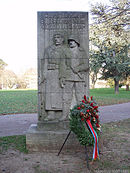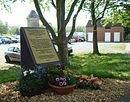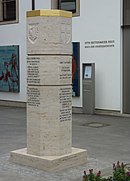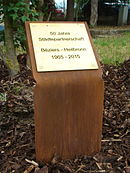List of monuments in Heilbronn
The list of monuments in Heilbronn provides an overview of the monuments and memorials in Heilbronn . The list does not claim to be exhaustive and only enumerates the monuments and memorials in the city center. Monuments in the incorporated districts are dealt with in the district articles.
For further art and cultural monuments of the city see also the list of Heilbronn buildings , list of fountains in Heilbronn and sculptures in Heilbronn .
List of monuments and memorials
| designation | Construction year | description | image |
|---|---|---|---|
| Memorial stone for the Maria Theresa Order of 1815 | 1861/1953 | The stone, which was once located on Theresienwiese , but has been erected south of Karlsruher Strasse at the corner of Karlsruher and Theresienstrasse since the Neckar Canal was built, is a reminder of the Maria Theresa Order Festival celebrated in 1815 , which gave Theresienwiese its name. The original memorial stone from 1861 was damaged in World War II and replaced by a copy in 1953 when the area around the Neckar Canal was redesigned. |

|
| Warrior memorial for 1870/71 | 1873 | The monument erected in the Old Cemetery in 1873 is the oldest war memorial in Heilbronn and is intended to commemorate 16 soldiers who died in Heilbronn hospitals during the Franco-German War in 1870/71. The monument was designed by Robert von Reinhardt in the style of a sarcophagus . The sarcophagus bears plaques with the names of theaters of war, surrounded by wreaths and crossed swords. The names of the 16 deceased are engraved on stone slabs at floor level. The graves of the deceased were once around the monument. |

|
| Robert Mayer Memorial | 1892 | The work of art comes from Wilhelm von Rümann . The monument shows the seated and larger than life bronze figure of Robert Mayer on a pedestal . The scientist is flanked by two fountains with the figures of a boy with a weight ( kilo ) and a little girl with a torch (calorie), an allusion to the kilocalorie . The memorial was unveiled on the market square in 1892, moved to the southern avenue in 1939 and was located in the city garden from 1959. In the course of the redesign of the harmony and the construction of the tram route from 2000, the monument was placed back on the market square. |

|
| Kaiser Wilhelm Monument | 1893 | The idea of erecting a memorial for Kaiser Wilhelm I in Heilbronn came up immediately after his death in March 1888. After initially favoring designs by Otto Rieth that would have glorified Wilhelm as a soldier emperor, the poet and democrat Ludwig Pfau took up the matter in 1889 , after whose ideas the monument was finally designed by the Munich sculptor Wilhelm von Rümann and the architects Ludwig Eisenlohr and Carl Weigle was executed in bronze, granite and marble. The monument is 5.90 m high, 2.90 m wide and 3.70 m deep and features a complex program of figures, the main message of which is the internal unification of Germany. A seated woman who tries to bring two boys together with her hands stands for the allegorical figure Germania , the children for northern and southern Germany. The introspective attitude of Germania is striking, as it was only very rarely portrayed at that time. Wilhelm I is depicted in a portrait medallion above the seated woman. The monument is crowned by the winged goddess of victory Viktoria, who carries the German imperial crown in her hands. Plaques also name the most important events of the Franco-Prussian War of 1870/71. The memorial was unveiled on September 2, 1893 in front of the Harmonie festival hall on Heilbronner Allee . It has stood in the Old Cemetery since 1959 on the site of the old morgue that was destroyed in 1944 and housed the Robert Mayer Museum from 1916 and the Alfred Schliz Museum from 1935. |

|
| Bismarck monument | 1903 | Shortly after Bismarck's death on July 30, 1898, a committee was formed in Heilbronn to erect a Bismarck memorial , chaired by the then Mayor Paul Hegelmaier . The bronze figure is 4.20 m high and was designed by sculptor Emil Kiemlen in 1903 and manufactured in the Paul Stotz foundry in Stuttgart. The Berlin architect Prof. Otto Rieth designed the base . The memorial was ceremoniously unveiled on July 30, 1903 in the Neckarlust complex built in 1871/72 by the Neckar Bridge (today: Kurt-Schumacher-Platz). Around the actual monument there was a courtyard raised by a few steps, the corner posts of which showed the reliefs of a crowned and a winged Germania . The main courtyard was later removed, and after 1987 the memorial was moved to Bismarckpark. |

|
| Regimental memorials for 1914–1918 | ? | For the dead of the infantry and fusilier regiments stationed in Heilbronn, monuments were erected in Kaiser Wilhelm Park (today: Friedenspark) after the First World War :
|
 
|
| Warrior Memorial in the Harbor Market Tower | ? | The historic Hafenmarktturm was redesigned in 1929–1936 as a war memorial for the fallen soldiers of the First World War based on designs by the architect Paul Bonatz and the sculptors Erwin Scheerer , Wilhelm Schäffer and Karl Dübbers . In addition to the inscription 1914–1918 / 2080 Sons of the City died for Germany , a total of 2082 names are listed in the memorial, including the names of 27 Jewish soldiers removed during the Third Reich. A relief on the north wall of the tower commemorates the missing of the 215th Infantry Division. Another commemorative plaque commemorates the I. Division of Artillery Regiment 71, Infantry Regiment 34 and Fortress Pioneer Staff 10. |

|
| Memorial for the displaced | 1985 | In May 1985, to the right of the exit from the Hafenmarkt tower to the Hafenmarktpassage, a memorial was erected for those who were displaced during the Second World War. |

|
| Debris Clearance Memorial | 2003 | In front of the Hafenmarktturm there is the memorial for the men and women who took part in the clearing of the rubble , a two-part bronze sculpture by Sabina Grzimek from 2003. |

|
| Memorial to Polish war victims | 1946 | Erected by former Polish slave laborers in the DP camp of the former Priesterwald barracks (later: Wharton Barracks ) to commemorate their compatriots who died in World War II. The metal cross built from rubble on a brick base was classified as a cultural monument in 1998. It is surrounded by greenery on Charlottenstrasse. In the main cemetery there is another memorial near the graves of deceased Poles. |

|
| Monuments in the main cemetery | ? | A stone in the main cemetery behind an exposed row of tombs commemorates the 13 Heilbronn teachers and students who were buried there and who died in the Heilbronn Dachstein accident on Good Friday in 1954 . Above the mass grave of euthanasia victims in Department 31 is a grave slab with the inscription: Your death is an obligation for all of us |

|
| Monuments in the Jewish cemetery | ? | In the Jewish cemetery there is a memorial for the 30 Jews who fell in Heilbronn during the First World War, a memorial stone from 1984 for the victims of the persecution of Jews from 1933 to 1945, and another memorial stone from 1984 for several unknown people who were buried there in spring 1943 as well as a memorial from 1987 with the names of the 235 Heilbronn Jews who perished during National Socialism. |
   
|
| Synagogue memorial plaque | 1966 | A plaque on the avenue commemorates the destruction of the Heilbronn synagogue . |

|
| Dome memorial | 1993 | Memorial for the destruction of the synagogue on November 10, 1938. Bettina Bürkle's dome is located near the memorial plaque for the Heilbronn synagogue on Allee and is intended to simulate the burned-out synagogue dome . The dome is made of COR-TEN steel and is on loan from the German-Jewish Circle of Friends of Heilbronn. |

|
| Memorial stone on the forest heather | ? / 1998 | A plaque on a boulder on the Waldheide commemorates the Pershing II rocket accident on January 11, 1985, which left three dead and 16 injured. During the withdrawal of the US Army, the tablet was lost under circumstances that have not yet been clarified. The city of Heilbronn then commissioned a reconstruction, which was unveiled in June 1998.
Memorial ceremonies for veterans of the US armed forces and the American community in Heilbronn take place here every year on January 11 and September 11 . |

|
| Vintner memorial stone | ? | On the Wein-Panorama-Weg on the Wartberg there is a memorial stone from Heilbronn winemakers for those who fell in the Second World War and those who died in the air raid on Heilbronn on December 4, 1944 among the families of the Heilbronn vineyards. |

|
| Monument to the Franciscan Monastery | ? | A Gothic window in the Hafenmarktpassage (Gustav-Binder-Straße) on the Hafenmarkt Tower reminds of the Franciscan monastery that existed until 1544 and the Hafenmarktkirche, which was burned down by the French in 1688. |

|
| Wall of the Klarakloster | ? | Remnants of the wall of the Klarakloster , founded in the 14th century, secularized and demolished in the 19th century, are still preserved in Siebeneichgasse. A plaque on the wall reminds of the former monastery. Another memorial plaque commemorates the location of the former high office prison, in which opponents of Hitler were temporarily imprisoned. Among the prisoners was the Heilbronn metalworker Gottlob Feidengruber (1901–1944), who managed to escape from the Oberamts prison on August 16, 1934. After his escape, Feidengruber continued to work in the resistance in France and was executed in Paris in 1944. |

|
| Bridge mill memorial stone | 1936 | Memorial stone for the bridge mill, which was owned by the city in 1442, rebuilt in 1574 and expanded in 1835. In 1936, the mill was demolished and erected at this point on the crane island of the Hagenbucher (oil seed storage of the Carl Hagenbucher mill), in whose southern side wall the memorial stone and a historic sandstone archway from 1596 are set. |

|
| State Horticultural Show Memorial | 1985 | A memorial stone made of red sandstone at the entrance to Wertwiesenpark commemorates the successful Baden-Württemberg State Horticultural Show in 1985, which gave rise to the redesign of the Neckaraue into a park. The garden show was visited by around one million people. |

|
| Schiller bust | 1891 | After a memorial plaque for Friedrich Schiller had been on his temporary home in Heilbronn as early as 1859 , an 85 cm high bronze bust of the poet (based on the famous marble bust of Johann Heinrich Dannecker ) was placed on a sandstone plinth on the avenue in 1891 . The bust was stolen in 1922, but was later found again. After the bust survived the Second World War, it was moved to the Stadtgarten bei der Harmonie in 1960 , where it was overthrown from its base by strangers in 1993. Since then, the bust has been kept in the storeroom of the municipal museum and only occasionally presented at events. | |
| Memorial stone for FA von Alberti | ? | In the old cemetery, a memorial stone commemorates Friedrich August von Alberti , the scientist and researcher of international repute, founder of Württemberg geology, creator of the term Trias, discoverer of new salt deposits and head of the Wilhelmshall and Friedrichshall salt pans. |

|
| Louis Link bust | ? | Dedicated to the memory of Heilbronn councilor Louis Link (1827–1889), whose heirs donated the Katharinenstift old people's and nursing home in Arndtstraße in 1894 , in front of which the bust is placed. Designed according to a design by Prof. Anton Hess . A street in Heilbronn is named after Link. |

|
| Theodor Heuss memorial plaque | 2006 | Since July 2006, a memorial plaque at Lerchenstrasse 43 has been commemorating the house where Theodor Heuss spent his youth, which was destroyed in World War II . The bronze plaque designed by the sculptor Markus Wolf was donated by the manufacturer Otto Rettenmaier , Honorary Senator of the University of Hohenheim. |

|
| Memorial plaque for Michéle Kiesewetter and ten victims of neo-Nazi violence | 2007/2012 | At Theresienwiese am Neckar a plaque commemorates the policewoman Michéle Kiesewetter (1984–2007), who was killed in the Heilbronn police murder near this spot on April 25, 2007 , as well as the other victims of the same group of perpetrators. The act in Heilbronn was attributed to the " Heilbronn Phantom " for a long time because of the DNA traces found at the crime scene . The first memorial plaque at this point was put up on October 17, 2007 by the Mayor of Heilbronn, Helmut Himmelsbach, and the State Police President Erwin Hetger. Just a few days after the plaque was put up, the memorial was desecrated for the first time, with strangers devastating the floral decorations. Another violent crime occurred on January 9, 2008, when three previously convicted and drunken rioters stepped on the blackboard and knocked an intervening pensioner unconscious. On the night of February 2, 2008, the old memorial plaque, including the concrete base, was excavated by strangers and completely removed. A few days later the board was found only slightly damaged by divers in the nearby Neckar Canal, cleaned and put back up on February 14, 2008. On the fifth anniversary of the crime, April 25, 2012, today's memorial plaque was unveiled, commemorating all known victims of the group of perpetrators. |
 
|
| Staufer stele | 2014 | In front of the Haus der Stadtgeschichte at Eichgasse 1, a 2.75 meter high Staufer column was inaugurated by Markus Wolf on March 1, 2014 . She reminds u. a. to the Nordheim Treaty , concluded under the Hohenstaufen king Heinrich (VII.) in 1225 , which was an important impetus for the development of Heilbronn into an imperial city. |

|
| Commemorative plaque 50 years of twinning between Béziers and Heilbronn | 2015 | In 2015, on the occasion of the 50th anniversary of the city partnership with Béziers | planted a tree and put up a plaque. The type of the plaque corresponds to the first version of the memorial plaque erected in 2007 for the policewoman who was shot on the Theresienwiese. |

|
See also
literature
- Julius Fekete: Art and cultural monuments in the city and district of Heilbronn. Theiss, Stuttgart 1991.
- Uwe Jacobi: Heilbronn, the city and its surroundings. Koval 1999.
- Uwe Jacobi: Heilbronn as it was. Droste, Düsseldorf 1987.
Individual evidence
- ^ Kilian Krauth: Emperor and Tsar celebrated in Heilbronn . In: Heilbronn voice . August 8, 2015.
- ^ Friedemann Schmoll: Hundred Years of Kaiser Wilhelm Memorial . In: Swabia and Franconia. Local history supplement of the Heilbronn voice . 39th year, no. 4 . Heilbronner Voice publishing house, April 1993, ZDB -ID 128017-X .
- ↑ Friedrich Dürr: Heilbronner Chronik . 1st chapter. Photomechanical reprint. Heilbronn City Archives, Heilbronn 1986. p. 474.
- ↑ Uwe Jacobi: The end of the war. 1st edition. Heilbronn 1986.
- ↑ Uwe Jacobi: The missing council minutes. 1st edition. Heilbronn 1981, p. 85.
- ↑ Kilian Krauth: It's that easy to forget things . In: Heilbronner Voice from January 11, 2013 .
- ↑ Bärbel Kistner: Three killed US soldiers are said to be unforgotten . In: Heilbronn voice from January 10, 2011 . ( from Stimme.de [accessed on May 7, 2013]).
- ↑ Helmut Buchholz: "We thought we were invulnerable" . In: Heilbronner Voice of September 9, 2011 . ( from Stimme.de [accessed on May 7, 2013]).
- ↑ http://www.heilbronn-marketing.de/hn_content.asp?hmg=1xx13xx103xx0xx0&lang=01
- ↑ Archived copy ( Memento of the original dated May 6, 2012 in the Internet Archive ) Info: The archive link was inserted automatically and has not yet been checked. Please check the original and archive link according to the instructions and then remove this notice.
- ↑ Holger Schmidt: Change of location: The Schiller bust in Heilbronn - a tg-GFS small project for the Schiller Year 2005 ( Memento from January 6, 2008 in the Internet Archive )
- ↑ Memorial plaque for Theodor Heuss on heilbronn.de ( Memento from August 1, 2012 in the web archive archive.today )
-
↑ Helmut Buchholz: Memorial against violence, a sign of thanks. In: Heilbronn voice . October 18, 2007.
Memorial plaque for murdered policewoman. In: Heilbronn Newsletter No. 42 October 18, 2007. - ↑ Memorial desecrated for policewoman. In: Heilbronn voice. October 30, 2007.
- ↑ Helmut Buchholz: Young trio brutally beat pensioners down . In: Heilbronn voice . January 10, 2008 ( from Stimme.de [accessed on September 23, 2012]).
- ↑ Carsten Friese: Prison sentences for the young thugs . In: Heilbronn voice . May 30, 2008 ( from Stimme.de [accessed on September 23, 2012]).
- ↑ Memorial plaque thrown into the Neckar. Spiegel Online , February 2, 2008.
- ↑ The memorial plaque for the policewoman should be back soon. Report on swr.de, February 5, 2008.
- ↑ The memorial plaque is back on Theresienwiese. In: Heilbronn voice. February 15, 2008.
- ↑ mut / red: Moving memorial service on Theresienwiese . In: Heilbronn voice . April 25, 2012 ( from Stimme.de [accessed on September 23, 2012]).
- ↑ Stauferstele Heilbronn on stauferstelen.net with historical background information. Retrieved March 9, 2014.